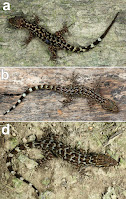 |
| Cyrtodactylus arunachalensis |
Abstract
We here describe a new species of bent-toed geckos from the northeastern Indian state of Arunachal Pradesh, which is widespread across the Dafla and Mishmi hills, occurring at elevations ranging from 179 m to 1400 m. The new species is recovered as sister to the Cyrtodactylus khasiensis clade based on a molecular phylogeny inferred from mitochondrial NADH-ubiquinone oxidoreductase, subunit 2 gene. Intraspecific uncorrected pairwise sequence divergence (p-distance) for the new species was found to be between 0 and 5%, whereas the interspecific divergence from the closely-related congeners was between 19 and 30%. The new species can be differentiated from members of the C. khasiensis clade using a suite of morphological characters: moderate body size (SVL 64.9–81.7); 8–11 supralabials; 8–10 infralabials; 24–26 bluntly conical, feebly keeled dorsal tubercles; 50–60 paravertebral tubercles; ~38 ventral scales between ventrolateral folds; no precloacal groves; 6–10 precloacofemoral pores in a continuous series; 10–16 distal subdigital lamellae on IV of pes; subcaudal scalation of original tail without enlarged plates. This is the fourth reptile species described from Arunachal Pradesh from the expedition led by the team, and this further highlights the need for further herpetological investigations into the region.
Key Words: Bent-toed gecko, cryptic species, Himalayas, ND2, northeast India, widespread
 |
| Figure 4. Cyrtodactylus arunachalensis sp. nov. in life (a) male holotype BNHS 2775, (b) paratype male BNHS 2777, (c) male NCBS NRC-AA-0008, (d) male BNHS 2778. Photographs by Zeeshan A. Mirza |
Cyrtodactylus arunachalensis sp. nov.
Cyrtodactylus sp. Agarwal et al. (2014): 147
Diagnosis: Cyrtodactylus arunachalensis sp. nov. can be distinguished from members of the khasiensis group by its: moderate body size (SVL 64.9–81.7, mean 70.6); 8–11 supralabials; 8–10 infralabials; 24–26 rows of bluntly conical, feebly keeled dorsal tubercles; 50–60 paravertebral tubercles; ~38 ventral scales between ventrolateral folds; no precloacal groves; 6–10 precloacofemoral pores in a continuous series; three to four rows of enlarged scales below pored scales, slightly larger than pored scales; 10–16 distal subdigital lamellae on IV of pes; subcaudal scalation of original tail without enlarged plates.
Etymology: The specific epithet is refers to the state of Arunachal Pradesh in northeast India where the species was discovered.
Natural history notes: All the specimens of the new species were collected form near culverts along roads just after dusk. Other than the concrete culverts, individuals were also observed on tree trunks, low branches, broad-leafed shrubs and rocky cliffs. The species was found in sympatry with Hemidactylus cf. malcolmsmithi, H. cf. frenatus and H. platyurus. The species appears to be distributed across the state and confirmed localities where it exists are Pakke Tiger Reserve, Papum Pare district and Kamlang Wildlife Sanctuary with recorded elevation ranging from 170 to 1400 m (Fig. 5).
Zeeshan A. Mirza, Harshal Bhosale, Faizan Ansari, Pushkar Phansalkar, Mandar Sawant, Gaurang Gowande and Harshil Patel. 2021. A New Species of Geckos of the Genus Cyrtodactylus Gray, 1827 from Arunachal Pradesh, India. Evolutionary Systematics. 5(1): 13-23. DOI: 10.3897/evolsyst.5.61667






